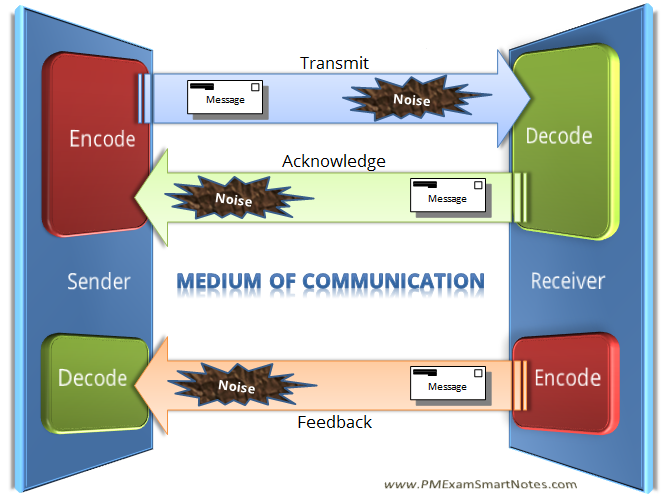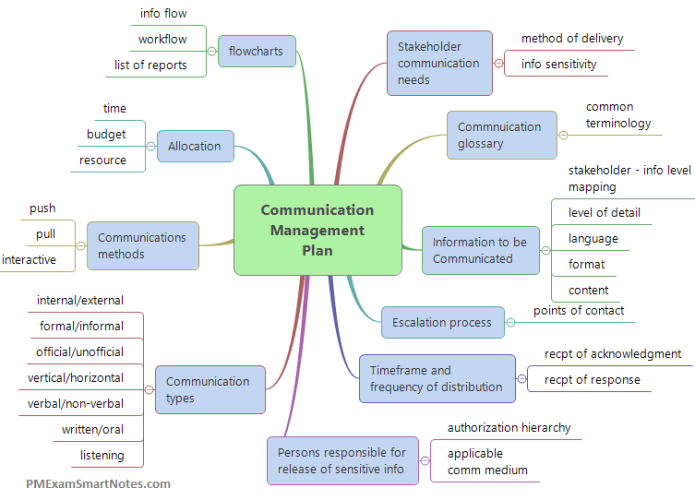Plan communications and communicate the plan.

“Science may never come up with a better office communication system than the coffee break.”
– Earl Wilson
A project generates loads of information. Not all of it will be relevant to everyone. Not getting right information or getting irrelevant information – both are not ideal.
Communication planning is all about deciding who should get which information, when, and who should send it, in what format and by which channel.
It takes into account the existing communication methods, channels, policies, and best practices and of course the lessons learned from earlier projects in the organization.
Critical information such as financials and contractual data is not for consumption by everyone, and can create issues or pose risks for project success if reaches wrong stakeholders.
Communication plan is something that is created, at least to some extent, at the early stages of the project. Potentially as soon as stakeholders are identified in the Initiating stage. Once stakeholders are identified, they need to be communicated to make any progress on the project. So as one can see the communication plan is something that is iterated and developed incrementally.
Also, this plan is prone to regular changes because of the changes in stakeholder engagement practices, their needs, and of course the feedback project manager receives from stakeholders about communication, or change requests raised due to conflicts in the project.
Planning for communication needs a bunch of things
We discussed that communication planning is done in the early stages of the project, at which point one of the project documents available to use is the Project charter. This helps us identify key stakeholders and their communication needs.
Project plan – where else do we start, right? Stakeholder management plan and Resource management plan are two plans that will be looked at in order to identify communication needs on the project.
Project documents such as Requirements documentation and Stakeholder register are referred to. The latter provides information about all people who are going to be affected by the execution, or output of the project; all people who may affect the project; and all those who think they are going to be affected. Knowing these people is important from communications perspective so proper information can be given to them at the right time to keep them happy, and enable them to make decisions.
Knowing organizational structure, and policies regarding information flow along the hierarchy, templates, communication plans from earlier projects and documented lessons learnt by other project managers will help plan well.
How’s it done?
Analyzing communications requirements
The main goal would be to figure out who should be given what information and when.
People should not be overwhelmed with amount and frequency of information coming their way. Some project managers go for a safer approach of distributing all information to everyone, with an assumption that people will take what they want and discard the rest. But this is an inefficient approach – in the clutter of information people may miss important information they really need. Also this may disclose sensitive information to wrong stakeholders.
You can figure out number of potential communication channels using the formula –
Total communication channels = n(n-1)/2
So, if you had 15 stakeholders then there will be 15×14/2=105 potential channels of communication. You may not use all of them, but you can use this information to ensure that the communication plan does not leave out any of the stakeholders.
Using right communication technology
This is largely determined by the policies and practices that performing organization has in place. However, this can also be dictated by customer’s communication mechanisms. Some companies may have a centralized location like intranet, wiki, or file server to store common information. Certain type of information might have to be accessed from configuration area, or exchanged by emails.
Depending on the needs people may choose a convenient technology to communicate information such as a casual conversation, email, or posting in intranet. Some of the factors that influence the selection of proper communication technology are –
- Urgency for the information – if the team is co-located then all major decisions may be communicated by means of a meeting
- Availability of technology – if teleconference facility is available then weekly calls across teams from different geographies can be held using this facility
- Ease of use
- Sensitivity and confidentiality of information – all sensitive and confidential information might have to be sent via encrypted email via secure channel
Using appropriate communication models
We saw the mechanism of information exchange between two parties in basic communication model lesson. Here it is, again. The components of this model are –
- Sender: anyone or any system that initiates the message
- Receiver: anyone or any system that receives the message
- Message: piece of information
- Medium: a means by which message is transmitted between sender and receiver
- Acknowledgement: confirmation of receipt of message by receiver, sent back to sender
- Feedback: response to the message from receiver
- Noise: anything that interferes with the transmission of message or acknowledgement. For instance, distance, unfamiliar technology, lack of background information or language

As per the model, sender would have to ensure that information is encoded in the right way so that receiver can decode, process it and send feedback properly.
Using right communication methods
…used in a project are –
- Push – where information is pushed to the receiver, either manually or automatically. For instance, in a software project, whenever code is checked into Version Control System an automated mail can be configured to be sent to everyone on the team.
- Pull – where information is kept in a centralized place and receiver will pull it whenever required. Project documents, test plans, project metrics might be placed in a centralized file server, and anyone on the team (or as per access restriction) can pull the information.
- Interactive – this method has the advantage of making sure that that communication process is successful. All discussions, meetings, training sessions, phone calls, video-conferences fall into this method. The disadvantage of this method is that if content of discussion is not collated (manually or using technology), discussion summary not be available for future reference.

Communication Types
Meetings are an essential part of group communication. Care must be taken to conduct meetings with set agenda that is circulated among attendees in advance, have fixed start and end time, take minutes of meeting, elicit attendees to contribute by sharing their ideas and thoughts, and decide action items at the end of the meeting. After the meeting, notes must be circulated to concerned stakeholders.
What does Communications Management Plan contain?
This is the main document produced by this process. The plan contains, among others, the following –
- Stakeholder groups, and specific communication needs of each group
- Information, its structure and format, and frequency of communication for each stakeholder
- Person(s) responsible for each type of communication
- Communication methods and/or technologies to be used for each type of communication
- Issue escalation process and hierarchy, point of contact and turnaround time at each level
- Frequency and method of updating communication plan throughout the project life
- Flow diagrams showing information flow in the project
- Objective project performance reporting criteria and frequency of reporting. This enables stakeholders to provide information at regular, pre-determined intervals.
- Any perceived communication constraints and prescribed solutions
- Glossary of terminology used in the plan
Whichever document you use in a process, you might update it as more information is discovered. In this process they could be project schedule, stakeholder register or stakeholder management strategy.

Plan communication, and communicate the plan.
It is important for the project manager to ensure that all of the stakeholders understand the published communication plan and follow it to the hilt. She should also encourage them to talk about any questions or concerns about the plan. An effective communications plan is like lubrication to the engine. It will ensure smooth flow of information in the system and reduces unnecessary noise that brings down team’s productivity.
Now that we have planned for communication on the project, let us see how communication is managed during the project execution phase – a major challenge for the PM considering the fact that typically she spends over 90% of efforts in communication!



